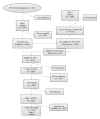Entry, Retention, and Virological Suppression in an HIV Cohort Study in India: Description of the Cascade of Care and Implications for Reducing HIV-Related Mortality in Low- and Middle-Income Countries
- PMID: 23935613
- PMCID: PMC3723357
- DOI: 10.1155/2013/384805
Entry, Retention, and Virological Suppression in an HIV Cohort Study in India: Description of the Cascade of Care and Implications for Reducing HIV-Related Mortality in Low- and Middle-Income Countries
Abstract
HIV treatment, care, and support programmes in low- and middle-income countries have traditionally focused more on patients remaining in care after the initiation of antiretroviral therapy (ART) than on earlier stages of care. This study describes the cumulative retention from HIV diagnosis to the achievement of virological suppression after ART initiation in an HIV cohort study in India. Of all patients diagnosed with HIV, 70% entered into care within three months. 65% of patients ineligible for ART at the first assessment were retained in pre-ART care. 67% of those eligible for ART initiated treatment within three months. 30% of patients who initiated ART died or were lost to followup, and 82% achieved virological suppression in the last viral load determination. Most attrition occurred the in pre-ART stages of care, and it was estimated that only 31% of patients diagnosed with HIV engaged in care and achieved virological suppression after ART initiation. The total mortality attributable to pre-ART attrition was considerably higher than the mortality for not achieving virological suppression. This study indicates that early entry into pre-ART care along with timely initiation of ART is more likely to reduce HIV-related mortality compared to achieving virological suppression.
Figures




References
-
- UNAIDS. 2012 UNAIDS Report on the Global AIDS Epidemic. 2012, http://www.unaids.org/en/media/unaids/contentassets/documents/epidemiolo....
-
- Adler A, Mounier-Jack S, Coker RJ. Late diagnosis of HIV in Europe: definitional and public health challenges. AIDS Care. 2009;21(3):284–293. - PubMed
-
- Girardi E, Sabin CA, Monforte AD. Late diagnosis of HIV infection: epidemiological features, consequences and strategies to encourage earlier testing. Journal of Acquired Immune Deficiency Syndromes. 2007;46(supplement 1):S3–S8. - PubMed
-
- Alvarez-Uria G, Midde M, Pakam R, Kannan S, Bachu L, Naik PK. Factors associated with late presentation of HIV and estimation of antiretroviral treatment need according to CD4 lymphocyte count in a resource-limited setting: data from an HIV cohort study in India. Interdisciplinary Perspectives on Infectious Diseases. 2012;2012:7 pages.293795 - PMC - PubMed
LinkOut - more resources
Full Text Sources
Other Literature Sources
Medical

